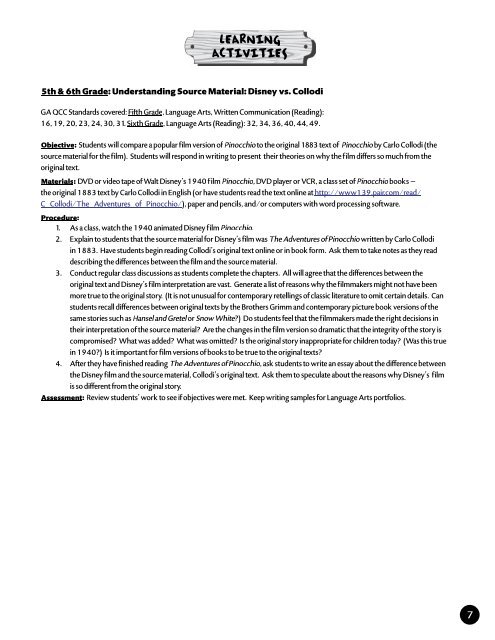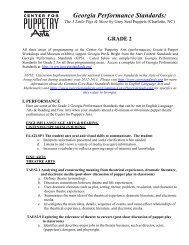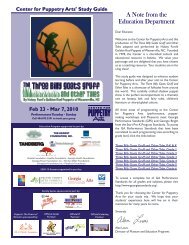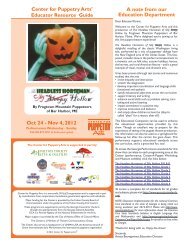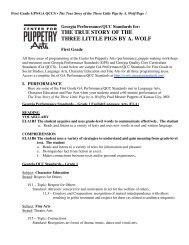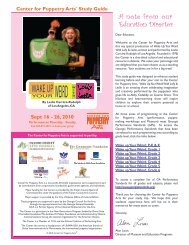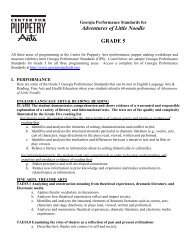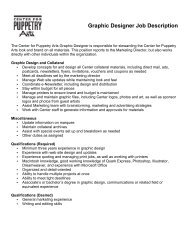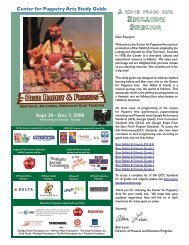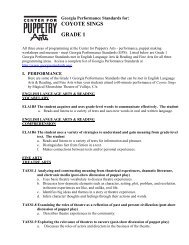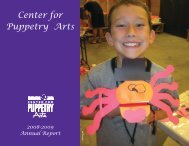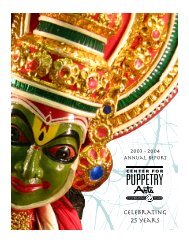Pinocchio - Center for Puppetry Arts
Pinocchio - Center for Puppetry Arts
Pinocchio - Center for Puppetry Arts
You also want an ePaper? Increase the reach of your titles
YUMPU automatically turns print PDFs into web optimized ePapers that Google loves.
learning<br />
activities<br />
5th & 6th Grade: Understanding Source Material: Disney vs. Collodi<br />
GA QCC Standards covered: Fifth Grade, Language <strong>Arts</strong>, Written Communication (Reading):<br />
16, 19, 20, 23, 24, 30, 31. Sixth Grade, Language <strong>Arts</strong> (Reading): 32, 34, 36, 40, 44, 49.<br />
Objective: Students will compare a popular f ilm version of<br />
<strong>Pinocchio</strong><br />
to the original 1883 text of<br />
<strong>Pinocchio</strong><br />
by Carlo<br />
Collodi (the<br />
source material <strong>for</strong> the f ilm). Students will respond in writing to present their theories on why the f ilm differs so much from the<br />
original text.<br />
Materials: DVD or video tape of Walt Disney’s 1940 f ilm<br />
<strong>Pinocchio</strong>, DVD player or VCR, a class set of <strong>Pinocchio</strong><br />
books –<br />
the original 1883 text by Carlo Collodi in English (or have students read the text online at http://www139.pair.com/read/<br />
C_Collodi/The_Adventures_of_<strong>Pinocchio</strong>/), paper and pencils, and/or computers with word processing software.<br />
Procedure:<br />
1. As a class, watch the 1940 animated Disney f ilm <strong>Pinocchio</strong>.<br />
2. Explain to students that the source material <strong>for</strong> Disney’s f ilm was The Adventures of <strong>Pinocchio</strong> written by Carlo Collodi<br />
in 1883. Have students begin reading Collodi’s original text online or in book <strong>for</strong>m. Ask them to take notes as they read<br />
describing the differences between the f ilm and the source material.<br />
3. Conduct regular class discussions as students complete the chapters. All will agree that the differences between the<br />
original text and Disney’s f ilm interpretation are vast. Generate a list of reasons why the f ilmmakers might not have been<br />
more true to the original story. (It is not unusual <strong>for</strong> contemporary retellings of classic literature to omit certain details. Can<br />
students recall differences between original texts by the Brothers Grimm and contemporary picture book versions of the<br />
same stories such as Hansel and Gretel or Snow White?) Do students feel that the f ilmmakers made the right decisions in<br />
their interpretation of the source material? Are the changes in the f ilm version so dramatic that the integrity of the story is<br />
compromised? What was added? What was omitted? Is the original story inappropriate <strong>for</strong> children today? (Was this true<br />
in 1940?) Is it important <strong>for</strong> f ilm versions of books to be true to the original texts?<br />
4. After they have f inished reading The Adventures of <strong>Pinocchio</strong>, ask students to write an essay about the difference between<br />
the Disney f ilm and the source material, Collodi’s original text. Ask them to speculate about the reasons why Disney’s f ilm<br />
is so different from the original story.<br />
Assessment: Review students’ work to see if objectives were met. Keep writing samples <strong>for</strong> Language <strong>Arts</strong> portfolios.<br />
7


